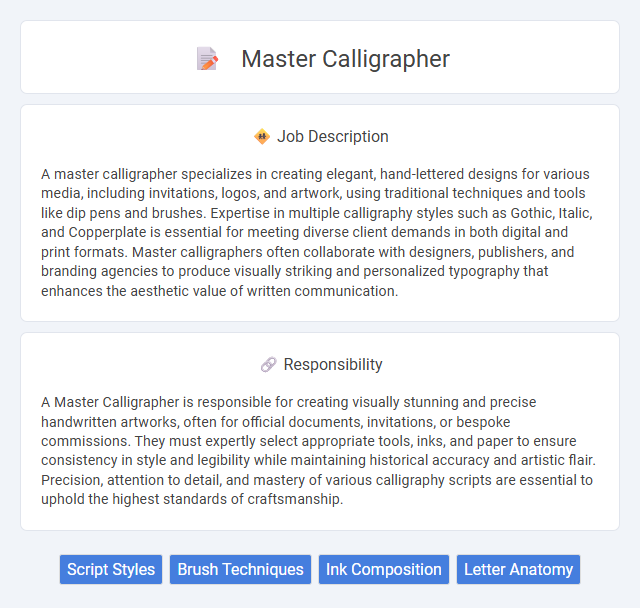
A master calligrapher specializes in creating elegant, hand-lettered designs for various media, including invitations, logos, and artwork, using traditional techniques and tools like dip pens and brushes. Expertise in multiple calligraphy styles such as Gothic, Italic, and Copperplate is essential for meeting diverse client demands in both digital and print formats. Master calligraphers often collaborate with designers, publishers, and branding agencies to produce visually striking and personalized typography that enhances the aesthetic value of written communication.
Individuals with steady hands, strong attention to detail, and patience are likely well-suited for the role of a master calligrapher. Those who thrive in quiet, focused environments and have a passion for artistic expression probably find this profession fulfilling. Conversely, people who struggle with fine motor skills or prefer fast-paced, dynamic work settings may find it challenging to succeed in this field.
Qualification
A master calligrapher must possess exceptional proficiency in various calligraphy styles, demonstrating refined hand control and artistic creativity. Extensive experience with traditional and digital tools, alongside a deep understanding of typographic principles and historical scripts, is essential. Formal training in fine arts or graphic design, combined with a robust portfolio showcasing diverse projects, enhances qualification credentials.
Responsibility
A Master Calligrapher is responsible for creating visually stunning and precise handwritten artworks, often for official documents, invitations, or bespoke commissions. They must expertly select appropriate tools, inks, and paper to ensure consistency in style and legibility while maintaining historical accuracy and artistic flair. Precision, attention to detail, and mastery of various calligraphy scripts are essential to uphold the highest standards of craftsmanship.
Benefit
Master calligraphers likely enjoy increased demand for their specialized skills, leading to higher earning potential and career stability. They probably benefit from opportunities to work on prestigious commissions, enhancing their professional reputation and portfolio. The role may also provide creative satisfaction and personal fulfillment through the art of beautifully crafted writing.
Challenge
A Master Calligrapher likely faces the challenge of maintaining perfect precision and consistency while creating intricate designs that demand immense concentration. The evolving demand for blending traditional techniques with modern styles may present additional difficulties in staying relevant. Managing time effectively to meet tight deadlines without compromising artistic quality could also be a significant challenge.
Career Advancement
Master calligraphers can advance their careers by developing specialized expertise in historic scripts or modern digital lettering techniques, enhancing their marketability. Establishing a strong portfolio and networking within art communities and calligraphy guilds often leads to commissions from prestigious clients and teaching opportunities. Progression to roles such as creative director or workshop leader allows greater influence in the design and calligraphy industry.
Key Terms
Script Styles
Master calligraphers specialize in various script styles such as Gothic, Italic, Copperplate, and Brush Script, each requiring precise technique and historical knowledge. Their expertise involves creating elegant, legible letterforms with careful attention to stroke, spacing, and flow, often used in invitations, certificates, and art pieces. Proficiency in script styles enhances visual communication and preserves traditional handwriting art in contemporary design.
Brush Techniques
Master calligraphers excel in brush techniques that control stroke thickness, fluidity, and pressure to create expressive characters. Precision in wrist movement and brush angle manipulation enables the creation of intricate lines and textures, showcasing artistic mastery. Mastery of ink flow and brush loading also ensures consistency and vibrancy in every stroke, essential for expert calligraphy.
Ink Composition
Master calligraphers expertly formulate ink compositions to achieve optimal viscosity, pigmentation, and drying time tailored for various writing surfaces. They blend natural and synthetic pigments with binders such as gum arabic or shellac to ensure smooth flow and vibrant, lasting color. Precise ink composition directly influences the clarity and durability of calligraphic strokes, making it essential for high-quality manuscript production and artistic expression.
Letter Anatomy
Master calligraphers demonstrate expert knowledge of letter anatomy, skillfully crafting each character by controlling stroke thickness, contrast, and proportions. They analyze key components such as ascenders, descenders, serifs, and x-height to ensure visual harmony and legibility. Precision in interpreting letterforms directly impacts the aesthetic quality and coherence of handwritten or digitally rendered text.
 kuljobs.com
kuljobs.com